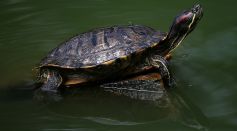ENVIRONMENT & CLIMATE

Landfill Pollutants Ranked Based on Toxicity To Combat Leachate

Extinct Tree-Climbing Kangaroo Species in Australia Discovered to be Relatives of Wallabies

People Discouraged From Kissing Pet Turtles Due To Deadly Salmonella Outbreak

Climate Change Disrupting Ocean Stability Faster Than Previously Thought [Study]
Genes of Half-Billion-Year-Old Sea Monsters Surprisingly Similar to Humans
Biodegradable Farming Alternatives May Answer Call to Resolve Plastic Content in Food

New "Map of Life" Shows Where Over 369 Undiscovered Species Might Still Thrive
Mountain Gorillas Commonly Adopt Young Orphaned Apes

20th Century Sea-Level Rise on East Coast Fastest in 2,000 Years

Driverless Air Taxis Could Fly Tourists to Restaurants 100-Feet Above the Ground
New Basalt Rock Formed After Volcanic Eruption Beneath the Pacific Ocean

2,500-Year-Old Mural is the Earliest Record of Salt as a Commodity Among Mayans

Brood X Cicadas Are Crawling Out of the Ground Sooner Than Expected
Origins of Hobbit Species Could Be Traced Back To Denisovans and Neanderthals
Most Popular

Why Stars Twinkle: Flickering Explained by Atmospheric Turbulence and Light Distortion

The Role of Materials Science in Engineering: How Modern Engineering Materials Drive Innovation

Tornadoes vs. Waterspouts vs. Dust Devils: Key Differences and Vortex Types Explained

Climate Adaptation Strategies Explained: How Societies Respond to Climate Change




